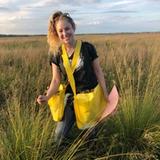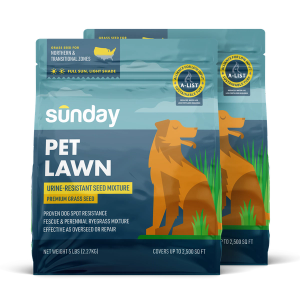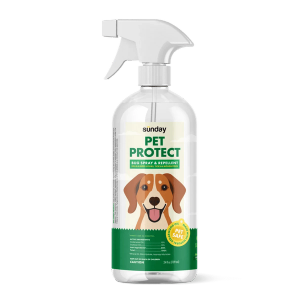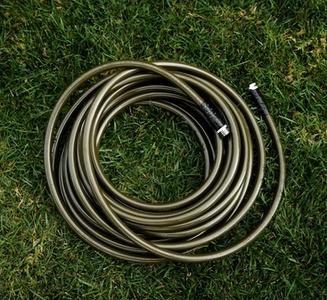The reality of raking fall leaves
We love a good leaf pile to jump in. But after the fun, it's best to use your rake for yard tidying instead of bagging leaves up.
Leaves that are piled in streets each year significantly contribute to phosphorus pollution in urban areas. Additionally, most municipal yard waste bags end up in landfills, not compost facilities.
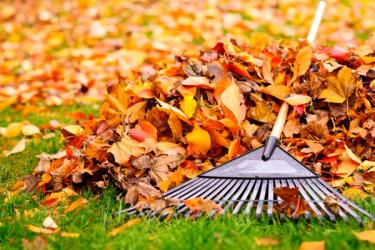
What is mulching leaves?
Mulching leaves involves mowing fall leaves back into your lawn, rather than raking and bagging them. This year, instead of discarding these valuable nutrients, consider mulching them back into your yard. This method helps boost soil nutrients, protect waterways, and prepares your turf for a healthy spring.
Before mulching fall leaves
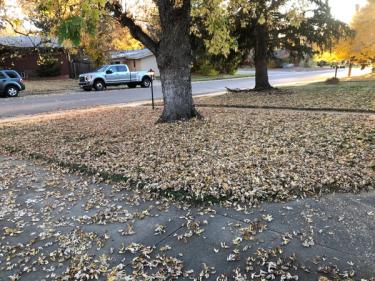
After mulching fall leaves
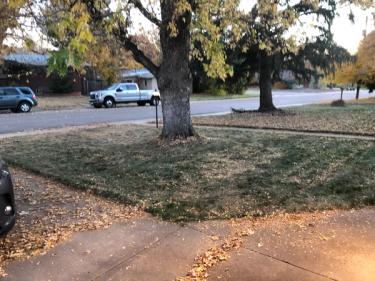
Why should you mulch autumn leaves?
Mulching leaves is one of the best ways to quickly return nutrients to the soil. Fall leaves from deciduous trees like maples and oaks are high in carbon but low in nitrogen, meaning they take longer to break down naturally. By mowing them, you can accelerate the breakdown process, allowing the nutrients to enrich your soil more quickly.
Fall lawn benefits of mulching
- Organic matter & nutrients: Build organic matter and recycle nutrients into your soil, promoting a greener lawn in the spring.
- Improved seeding: Prevent grass seeds from getting stuck in large leaf debris and aid in fall overseeding and frost seeding.
- Disease prevention: Limit the potential for bare patches, snow mold, and other diseases caused by wet, matted leaves covering the grass.
- Environmental protection: Reduce water pollution like excess nutrients from entering local waterways.
Sunday Tip:
Bonus? Mulching saves you money since you don’t have to purchase yard waste bags or pay for yard waste pickup.
How to mulch leaves in your lawn
Mulching is more than just mowing your lawn. Follow these steps for effective leaf mulching:
Prep your lawn
Make sure leaves are dry and the leaf layer is not so thick that mowing will stifle the grass below. Check your lawn for rocks, sticks, and other debris before mowing. While fallen leaves are good to mow, anything else can be harmful.
While doing this, make sure fallen leaves are spread across the lawn. You can even use your rake for this part!
Get your mower ready
Remove your lawn mower bag to distribute leaf mulch evenly across the lawn.
Next, lower your mowing height. Lower it 1-2 settings to make sure your blade is sufficiently able to shred leaves, but it’s not cutting your grass too low.
You want the grass to be like a shaggy carpet that can take all the small leaf pieces right in to nestle closer to the soil.
Mulch fall leaves
Mow your lawn in a typical pattern and try to get leaves to tiny nickel to dime-sized pieces.
If the first pass doesn’t break the leaves into small enough pieces, mow them again. The smaller the leaf bits are, the better, to ensure the pieces and nutrients can break down into the soil.
For lawns with a typically heavy layer of leaves, consider mulching as the leaves fall versus waiting for end of fall.
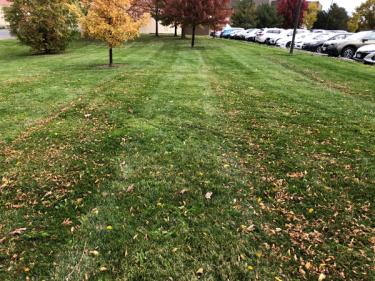
Mulching leaves FAQ
Do I need a mulching mower?
For optimal results, use a mulching mower. These lawnmowers can easily mulch grass clippings and leaves into fine pieces. With this tool, you can recycle nutrients back into your lawn all season long!
When should I start mulching leaves in fall?
The best time to start mulching is when about half of your lawn is still visible through the fallen leaves. Don’t wait for all the leaves to fall, as mulching too many at once can suffocate the grass.
What if I have a small lawn? Should I mulch?
Yes, small lawns also benefit from mulching. If you have too many leaves, follow our section below for what else to do with fall leaves.
How to manage
If the volume of leaves is too substantial for mulching, consider these alternatives:
- Start a compost pile: Leaves add essential “brown” material to your compost, balancing out green materials like fruit and vegetable scraps.
- Garden beds: Mix chopped-up leaves into garden beds to add organic matter and nutrients, or use intact leaves as a winter blanket for the beds.
- Wildlife habitat: Allow leaf piles along the edges of your yard or garden (away from the house!) to provide habitat for winter wildlife. Leaf litter benefits insects that aerate soil and birds that control pests like mosquitoes.
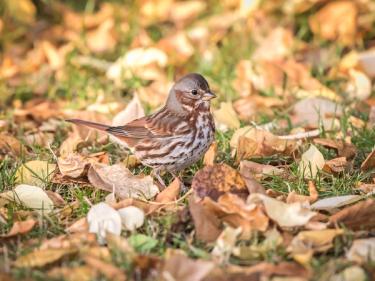
Fall into lawn care
Once you’ve managed your lawn's leaf litter, continue caring for your fall lawn. This includes aerating to prevent compaction, fertilizing to replenish fall nutrients, and managing fall weeds for a healthier spring comeback. And don’t forget to winterize your irrigation system and protect against frost damage.
By taking a few simple actions this fall, you’ll help your lawn bounce back happy and healthy in the spring. Enjoy the beautiful fall scenery and remember to share your leaf mulching tips or reach out if you need lawn care guidance!
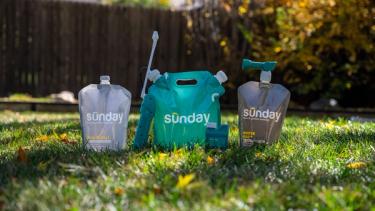
Let's get growing
Our lawn engine uses satellite data to map out your lawn size and determine things like average rainfall, common weeds, and pest activity.
Cited sources
Fall Leaves: To Leave or Not to Leave. Clemson University Extension.
Leave the leaves. North Carolina Cooperative Extension.
Leave the leaves! Xerces Society.
Mulch Mowing Fall Leaves. Kansas State University Extension.
Rethinking yard waste disposal. Institute of Food and Agricultural Sciences and University of Florida.
Solution for getting rid of fall leaves on the lawn. Kansas State University Extension.
Using Fallen Leaves. University of Illinois Extension.

